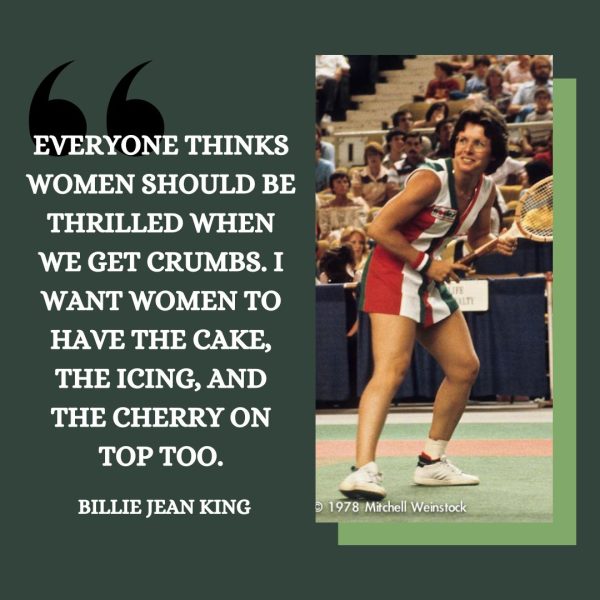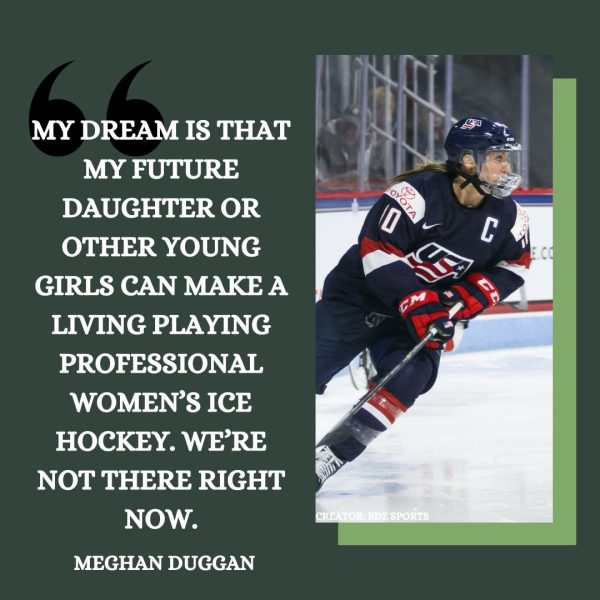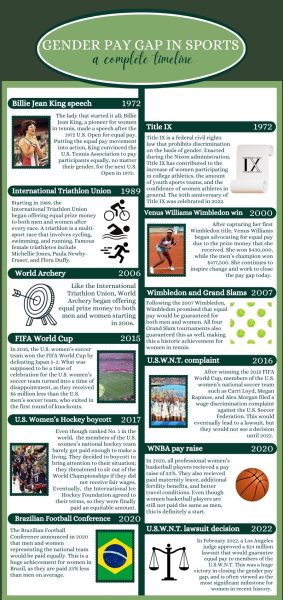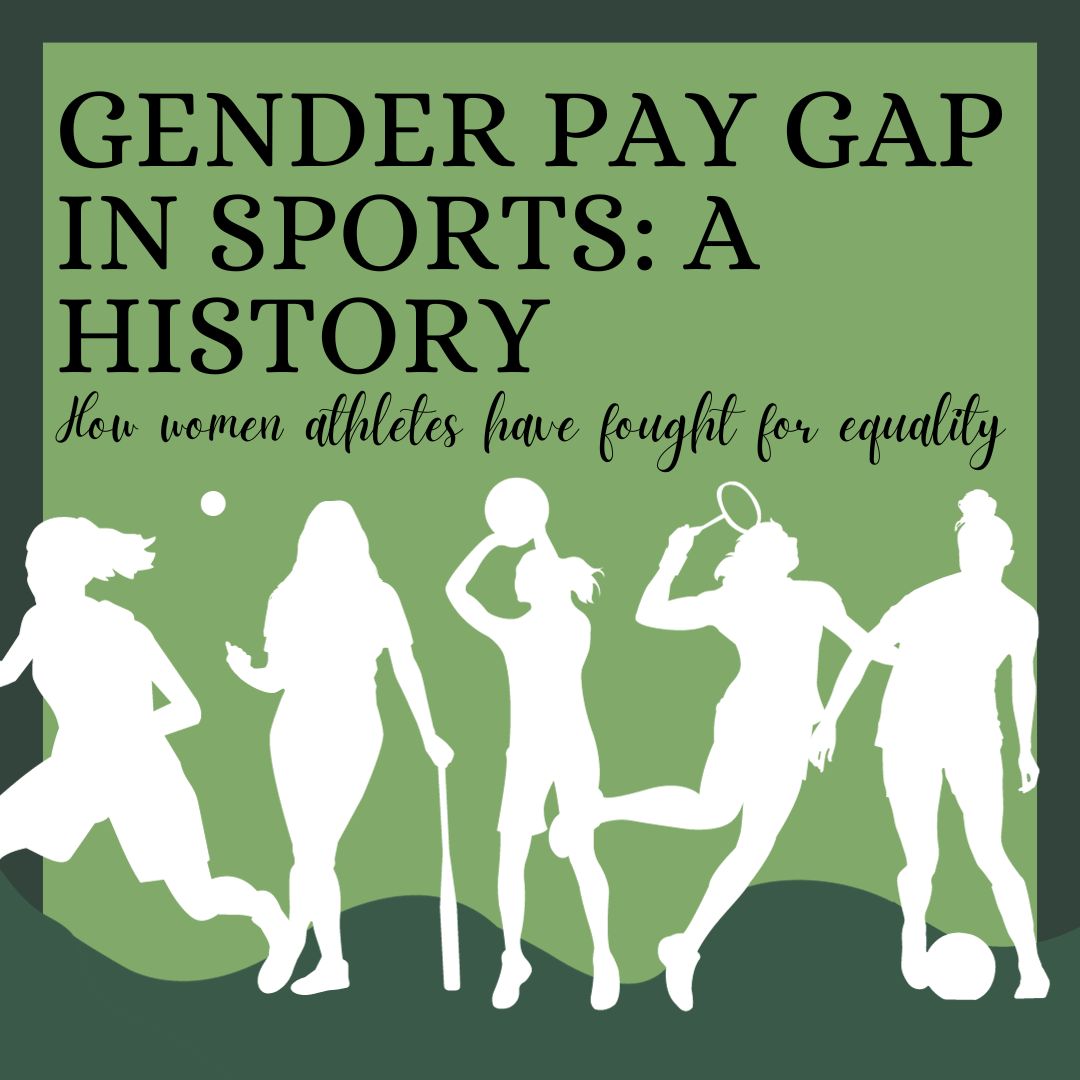On Feb. 22, 2022, a Los Angeles judge approved a $24 million lawsuit settlement that would guarantee equal pay to members of the United States Women’s National Soccer Team (USWNT) after they made national headlines for demanding equitable compensation as men in the wake of discrimination allegations. This would mark the USWNT as the first-ever women’s sports team to achieve equal pay, and although other teams are starting to accomplish the same, it is crucial that we recognize the extensive battle that women athletes have fought to shape pay standards.
Serena Williams. Ronda Rousey. Sabrina Ionescu. Names that come to mind when you think of female athlete trailblazers who constantly advocate for change. However, what some people may not know is that the long-running journey to change began over 50 years ago with 20-time Wimbledon champion Billie Jean King.

Instead of making typical remarks after winning the 1972 U.S. Open, King used her platform to speak out against the U.S. Tennis Association for the $15,000 difference between the women’s prize and the men’s prize.
“I don’t know what came over me, but inside my heart and soul said, ‘I don’t think we will be back next year unless we have equal prize money,’” said King in an interview with PBS.
Following her win, the U.S. Tennis Association announced that the prize money would be equal for both the women’s bracket and the men’s bracket for the next U.S. Open in 1973.
“I consider Billie Jean’s contributions to tennis important because if it wasn’t for her, women wouldn’t get paid as much in tennis as they do now,” said Maria Trepanier, a senior on the tennis team.
Although King’s advocacy changed Wimbledon, other non-Grand Slam tennis tournaments, such as the Italian Open and the South African Open, still award men more than women, according to Spectrum News NY1.
“As of now, women tennis players are still not paid equally as men, but King changed history for women on the courts,” said Trepanier. “I would say her contributions have inspired me not only as a tennis player, but also as an upcoming woman.”
Fast-forward almost 30 years later to the year 2000 and Venus Williams had just captured her first Wimbledon title by prevailing over defending champion Lindsey Davenport. In an interview with the New York Times, Williams described her victory as something that was “meant to be,” but also mentioned how she was appalled at the sizable prize difference.

“This is a real problem and we have to close this pay gap,” said Williams in an interview with USA Today.
Utilizing companies such as Credit Karma to call for equal pay in the workplace, Williams noted the greater pay gap for women of color and the disparities she has experienced as a woman of color in a male-dominated sport.
“The pay gap stems from systematic inequalities, whether that’s gender or race,” said Williams in an interview with Sports Illustrated. “When we talk about minorities, the gaps go wider. Outside the United States, the gap goes wide open. So this is an issue facing women all over the world.”
Beyond the sport of tennis, the United States women’s hockey team also tried to inspire change by boycotting the International Ice Hockey Foundation in 2017. Despite being ranked No. 1 in the world, the players barely got paid enough to make a living, so they threatened to sit out of the World Championships if they did not receive increased wages.

“We are asking for a living wage and for U.S.A. hockey to support its programs for women,” said team captain Meghan Duggan in an interview with NPR Milwaukee. “Stop treating us like an afterthought. We have represented our country with dignity and deserve to be treated with fairness and respect.”
The International Ice Hockey Foundation eventually chose to terminate the boycott by promising equal travel and insurance provisions, a split of the pool prize money, and a guaranteed stipend for each player, as well as larger performance bonuses for medalists.
These women athletes have fought for equal pay and the initiation of change, however women in sports, and frankly women in general, still have a long way to go. According to Adelphi University, basketball still has the largest pay gap, with golf coming in as a close second.
A professional women’s basketball player is paid $113,295 on average, whereas the average salary for a professional men’s basketball player comes to a grand total of $10,776,383. Golf, unfortunately, continues to highlight the same discrepancies with a $1,042,917 average salary for men and a $346,360 average salary for women.
“I understand that the NBA generates more revenue than the WNBA and that’s why the players in the NBA get paid as much as they do,” said girls’ basketball coach Jason Clark. “What I don’t like or understand is why the NBA doesn’t pour more of that revenue into the WNBA. WNBA players get paid more playing professionally overseas than here in the USA and that’s unacceptable. Last year the highest paid WNBA player made a little more than $240k while the starting base salary for the NBA is $5.4 million. That’s a pretty significant gap that shouldn’t be allowed.”
If you are interested in learning more about women’s fight to close the gender pay gap, please consider visiting the Women’s Sports Foundation to take a look at their objectives and hopes. Consider spreading the word, sharing stories on social media, or fundraising, as it is not solely the task of women athletes to change equity standards but everyone’s.








